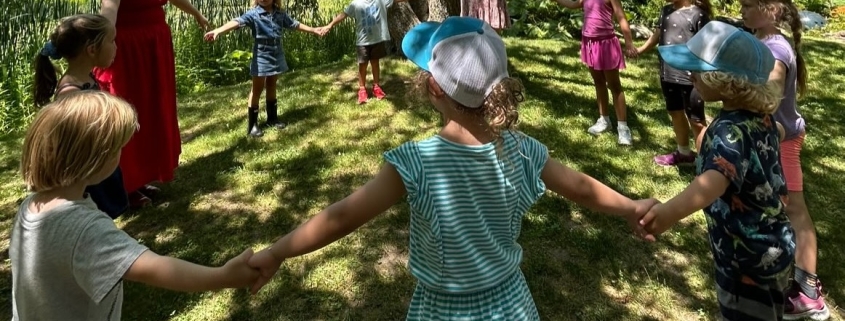Fall Health for Kids: Common Respiratory Illnesses and How To Boost Immunity
Sticky fingers. Muddy shoes. Shared crayons. It might look like chaos, but it’s actually biology in action. As the weather cools and classrooms fill up, colds, flu, and RSV start to make their rounds — reminding parents that fall fun often comes with a side of sniffles.
The truth is, everyday exposure to germs helps children’s immune systems grow stronger and more resilient. At Shine, we believe kids can stay healthy without living in a bubble. With the right mix of play, prevention, and rest, families can navigate the season with confidence — keeping the joy (and the germs) in healthy balance.
Common Respiratory Issues in Fall
When temperatures drop, kids spend more time indoors — often in close quarters with friends at school or activities — which makes it easier for viruses to spread. Dry indoor air can also irritate nasal passages, weakening the body’s first line of defense against infection. Meanwhile, many respiratory viruses (including RSV and influenza) thrive in cooler, less humid conditions, leading to a seasonal uptick in cases.
Here’s what to look out for when the temperatures dip:
- Common colds – runny or stuffy nose, mild cough, fatigue
- Flu – fever, body aches, chills, more severe respiratory symptoms, sometimes vomiting
- Strep throat – sore throat, fever, swollen lymph nodes, often stomach or head pain
- Sinusitis) – facial pain/pressure, nasal congestion, thick nasal discharge, low fever
- RSV – wheezing, rapid breathing, persistent cough, especially in younger children
- Seasonal allergies – sneezing, itchy eyes, congestion, long lasting symptoms
When in doubt, check with your pediatrician — especially as RSV and flu cases in the Hamptons area typically rise between late October and December.
Treating Sickness at Home
If your child’s feeling under the weather, these remedies can help:
- Fever & fatigue – fluids, rest, and easy-to-digest comfort foods like soups and soft fruits.
- Congestion & cough – cool-mist humidifier, warm showers, saline nasal sprays, or steam.
- Sore throat – warm saltwater gargle (for older kids) and soothing warm drinks.
- Nighttime cough – a teaspoon of honey (for children over 1 year).
- General comfort & easing symptoms – add a few drops of eucalyptus or peppermint oil to the shower to help open airways.
Why Germ Exposure Can Be Healthy
It might seem counterintuitive, but letting kids interact with peers, outdoor environments, and everyday germs helps their immune systems learn and adapt.
A study from Finland found that when daycare playgrounds were enriched with natural elements like forest undergrowth and lawn turf, children aged 3–5 developed a greater diversity of skin and gut microbes — and showed immune markers associated with better regulation and less inflammation.
Limited exposure to environmental microbes, on the other hand, has been linked to increased allergic sensitization and immune dysregulation. The pandemic created a kind of “immunity gap,” where children had fewer everyday exposures to common germs. As kids return to schools, playgrounds, and social activities, their immune systems will gradually get back on track, building resilience through normal, everyday interactions.
Steps Parents Can Take to Reduce Severity of Fall Illnesses
While some exposure is good, there are practical strategies to support your child’s health:
- Nutrition Matters
- Offer fruits and vegetables packed with vitamin C, zinc, and antioxidants.
- Keep kids hydrated with water or diluted juice — hydration helps the body clear mucus and recover faster.
- Prioritize Sleep
- Regular sleep routines boost immunity naturally.
- A kindergartener ideally gets about 11 hours of nightly rest.
- A 2nd–4th grader needs around 10 hours.
- An older child (5th–6th grade) should aim for 9–10 hours.
- Hygiene Without Over-Sanitizing
- Encourage proper handwashing before meals and after outdoor play.
- Avoid overusing antibacterial gel or wipes; everyday soap is sufficient.
- Monitor Symptoms
- Track fevers: If your child’s fever reaches 102F or higher, lasts more than 3 days, or returns after going away, it’s time to check in with your pediatrician.
- Watch coughs: A lingering cough that lasts beyond 10 days, sounds barky or wheezy, or interferes with sleep may indicate asthma, bronchitis, or another infection that needs medical attention.
- Notice breathing patterns: Rapid breathing, chest retractions (when the skin pulls in with each breath), or shortness of breath require prompt medical care.
- Pay attention to energy levels: Unusual fatigue, lethargy, or a sudden loss of appetite lasting more than 2-3 days can signal flu or a more serious illness.
- Trust your instincts: If your child’s color looks off, they seem unusually irritable, or you simply feel something isn’t right, it’s always appropriate to call your pediatrician — especially during high virus circulation in the fall.
- Encourage Active Play
- Physical activity outdoors improves lung function and overall resilience.
- Shine NYC’s programs emphasize playful learning indoors and outdoors — where kids can move, explore, and thrive.
Balancing Health and Fun
Fall should be full of discovery — not just doctor visits. When kids climb, share, create, and get a little messy, they’re not only building memories but strengthening their immune systems, too. With thoughtful habits and room for real-world play, families can enjoy a season that’s healthy, joyful, and wonderfully active.



